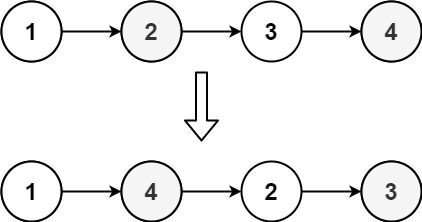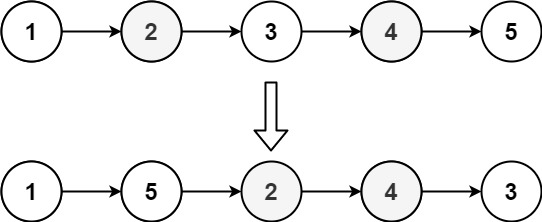英文原文
You are given the head of a singly linked-list. The list can be represented as:
L0 → L1 → … → Ln - 1 → Ln
Reorder the list to be on the following form:
L0 → Ln → L1 → Ln - 1 → L2 → Ln - 2 → …
You may not modify the values in the list's nodes. Only nodes themselves may be changed.
Example 1:

Input: head = [1,2,3,4] Output: [1,4,2,3]
Example 2:

Input: head = [1,2,3,4,5] Output: [1,5,2,4,3]
Constraints:
- The number of nodes in the list is in the range
[1, 5 * 104]. 1 <= Node.val <= 1000
中文题目
给定一个单链表 L 的头节点 head ,单链表 L 表示为:
L0 → L1 → … → Ln - 1 → Ln
请将其重新排列后变为:
L0 → Ln → L1 → Ln - 1 → L2 → Ln - 2 → …
不能只是单纯的改变节点内部的值,而是需要实际的进行节点交换。
示例 1:

输入:head = [1,2,3,4] 输出:[1,4,2,3]
示例 2:

输入:head = [1,2,3,4,5] 输出:[1,5,2,4,3]
提示:
- 链表的长度范围为
[1, 5 * 104] 1 <= node.val <= 1000
通过代码
高赞题解
题目描述(中等难度)

给一个链表,然后依次头尾头尾头尾取元素,组成新的链表。
解法一 存储
链表的缺点就是不能随机存储,当我们想取末尾元素的时候,只能从头遍历一遍,很耗费时间。第二次取末尾元素的时候,又得遍历一遍。
所以先来个简单粗暴的想法,把链表存储到线性表中,然后用双指针依次从头尾取元素即可。
public void reorderList(ListNode head) {
if (head == null) {
return;
}
//存到 list 中去
List<ListNode> list = new ArrayList<>();
while (head != null) {
list.add(head);
head = head.next;
}
//头尾指针依次取元素
int i = 0, j = list.size() - 1;
while (i < j) {
list.get(i).next = list.get(j);
i++;
//偶数个节点的情况,会提前相遇
if (i == j) {
break;
}
list.get(j).next = list.get(i);
j--;
}
list.get(i).next = null;
}解法二 递归
参考 这里。
解法一中也说到了,我们的问题就是取尾元素的时候,需要遍历一遍链表。
如果我们的递归函数能够返回当前头元素对应的尾元素,并且将头元素和尾元素之间的链表按要求完成,那就变得简单了。

如上图,我们只需要将 head 指向 tail,tail 指向处理完的链表头即可。

然后我们把之前的 tail.next 返回就是外层 head 对应的 tail 了。
递归出口的话,如果只有一个节点,那么我们只需要将 head.next 返回。
if (len == 1) {
ListNode outTail = head.next;
head.next = null;
return outTail;
}如果是两个节点,我们需要将 head.next.next 返回。
if (len == 2) {
ListNode outTail = head.next.next;
head.next.next = null;
return outTail;
}然后总体的代码就是下边的样子
public void reorderList(ListNode head) {
if (head == null || head.next == null || head.next.next == null) {
return;
}
int len = 0;
ListNode h = head;
//求出节点数
while (h != null) {
len++;
h = h.next;
}
reorderListHelper(head, len);
}
private ListNode reorderListHelper(ListNode head, int len) {
if (len == 1) {
ListNode outTail = head.next;
head.next = null;
return outTail;
}
if (len == 2) {
ListNode outTail = head.next.next;
head.next.next = null;
return outTail;
}
//得到对应的尾节点,并且将头结点和尾节点之间的链表通过递归处理
ListNode tail = reorderListHelper(head.next, len - 2);
ListNode subHead = head.next;//中间链表的头结点
head.next = tail;
ListNode outTail = tail.next; //上一层 head 对应的 tail
tail.next = subHead;
return outTail;
}解法三
参考 这里,主要是利用到一头一尾取元素的特性。
主要是三步,举个例子。
1 -> 2 -> 3 -> 4 -> 5 -> 6
第一步,将链表平均分成两半
1 -> 2 -> 3
4 -> 5 -> 6
第二步,将第二个链表逆序
1 -> 2 -> 3
6 -> 5 -> 4
第三步,依次连接两个链表
1 -> 6 -> 2 -> 5 -> 3 -> 4第一步找中点的话,可以应用 19 题 的方法,快慢指针。快指针一次走两步,慢指针一次走一步,当快指针走到终点的话,慢指针会刚好到中点。如果节点个数是偶数的话,slow 走到的是左端点,利用这一点,我们可以把奇数和偶数的情况合并,不需要分开考虑。
第二步链表逆序的话,在 第 2 题 讨论过了,有迭代和递归的两种方式,迭代的话主要利用两个指针,依次逆转。
第三步的话就很简单了,两个指针分别向后移动就可以。
public void reorderList(ListNode head) {
if (head == null || head.next == null || head.next.next == null) {
return;
}
//找中点,链表分成两个
ListNode slow = head;
ListNode fast = head;
while (fast.next != null && fast.next.next != null) {
slow = slow.next;
fast = fast.next.next;
}
ListNode newHead = slow.next;
slow.next = null;
//第二个链表倒置
newHead = reverseList(newHead);
//链表节点依次连接
while (newHead != null) {
ListNode temp = newHead.next;
newHead.next = head.next;
head.next = newHead;
head = newHead.next;
newHead = temp;
}
}
private ListNode reverseList(ListNode head) {
if (head == null) {
return null;
}
ListNode tail = head;
head = head.next;
tail.next = null;
while (head != null) {
ListNode temp = head.next;
head.next = tail;
tail = head;
head = temp;
}
return tail;
}总
解法一利用空间去存储就很简单了,解法二递归的思想也很经典,自己也想了很久,看到作者的思路才恍然大悟,判断当前 length 定义递归出口很巧妙。解法三主要就是对题目的理解,关键就是利用一头一尾取元素的特性。
统计信息
| 通过次数 | 提交次数 | AC比率 |
|---|---|---|
| 138166 | 221411 | 62.4% |
提交历史
| 提交时间 | 提交结果 | 执行时间 | 内存消耗 | 语言 |
|---|




